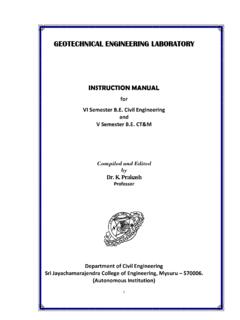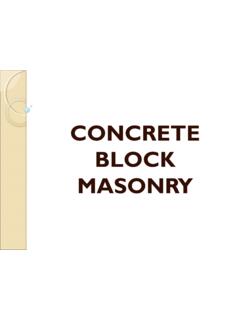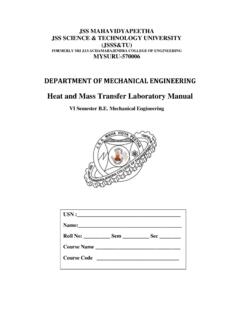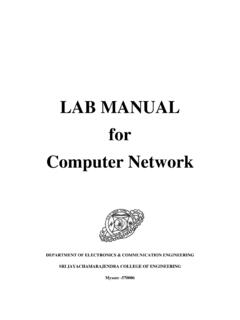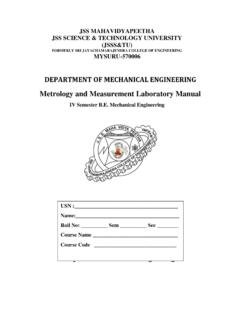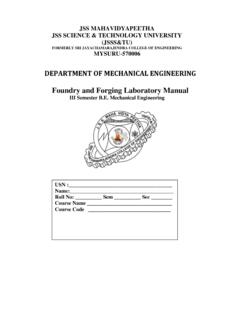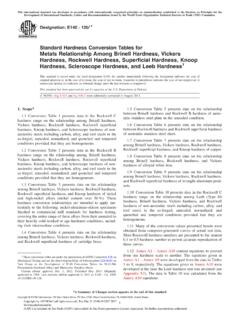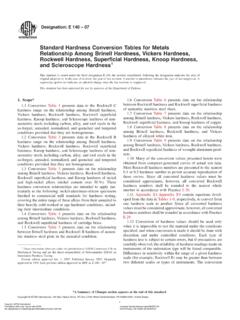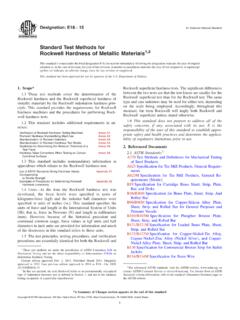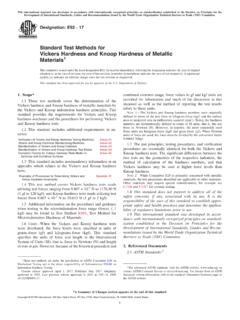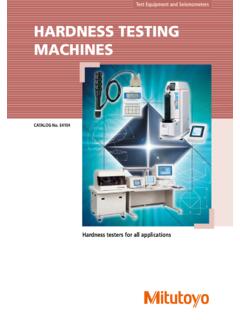Transcription of Basic Material Testing Laboratory Manual
1 JSS MAHAVIDYAPEETHA JSS SCIENCE & TECHNOLOGY UNIVERSITY (JSSS&TU) FORMERLY SRI JAYACHAMARAJENDRA COLLEGE OF ENGINEERING MYSURU-570006 DEPARTMENT OF MECHANICAL ENGINEERING Basic Material Testing Laboratory Manual IV Semester Mechanical Engineering USN :_____ Name:_____ Roll No: _____ Sem _____ Sec _____ Course Name _____ Course Code _____ DEPARTMENT OF MECHANICAL ENGINEERING VISION OF THE DEPARTMENT Department of mechanical engineering is committed to prepare graduates, post graduates and research scholars by providing them the best outcome based teaching-learning experience and scholarship enriched with professional ethics. MISSION OF THE DEPARTMENT M-1: Prepare globally acceptable graduates, post graduates and research scholars for their lifelong learning in Mechanical Engineering, Maintenance Engineering and Engineering Management.
2 M-2: Develop futuristic perspective in Research towards Science, Mechanical Engineering Maintenance Engineering and Engineering Management. M-3: Establish collaborations with Industrial and Research organizations to form strategic and meaningful partnerships. PROGRAM SPECIFIC OUTCOMES (PSOs) PSO1 Apply modern tools and skills in design and manufacturing to solve real world problems. PSO2 Apply managerial concepts and principles of management and drive global economic growth. PSO3 Apply thermal, fluid and materials fundamental knowledge and solve problem concerning environmental issues. PROGRAM EDUCATIONAL OBJECTIVES (PEOS) PEO1: To apply industrial manufacturing design system tools and necessary skills in the field of mechanical engineering in solving problems of the society.
3 PEO2: To apply principles of management and managerial concepts to enhance global economic growth. PEO3: To apply thermal, fluid and materials engineering concepts in solving problems concerning environmental pollution and fossil fuel depletion and work towards alternatives. PROGRAM OUTCOMES (POS) PO1 Engineering knowledge: Apply the knowledge of mathematics, science, engineering fundamentals, and an engineering specialization to the solution of complex engineering problems. PO2 Problem analysis: Identify, formulate, review research literature, and analyze complex engineering problems reaching substantiated conclusions using first principles of mathematics, natural sciences, and engineering sciences.
4 PO3 Design/development of solutions: Design solutions for complex engineering problems and design system components or processes that meet the specified needs with appropriate consideration for the public health and safety, and the cultural, societal, and environmental considerations. PO4 Conduct investigations of complex problems: Use research-based knowledge and research methods including design of experiments, analysis and interpretation of data, and synthesis of the information to provide valid conclusions. PO5 Modern tool usage: Create, select, and apply appropriate techniques, resources, and modern engineering and IT tools including prediction and modeling to complex engineering activities with an understanding of the limitations.
5 PO6 The engineer and society: Apply reasoning informed by the contextual knowledge to assess societal, health, safety, legal and cultural issues and the consequent responsibilities relevant to the professional engineering practice. PO7 Environment and sustainability: Understand the impact of the professional engineering solutions in societal and environmental contexts, and demonstrate the knowledge of, and need for sustainable development. PO8 Ethics: Apply ethical principles and commit to professional ethics and responsibilities and norms of the engineering practice. PO9 Individual and team work: Function effectively as an individual, and as a member or leader in diverse teams, and in multidisciplinary settings.
6 PO10 Communication: Communicate effectively on complex engineering activities with the engineering community and with society at large, such as, being able to comprehend and write effective reports and design documentation, make effective presentations, and give and receive clear instructions. PO11 Project management and finance: Demonstrate knowledge and understanding of the engineering and management principles and apply these to one s own work, as a member and leader in a team, to manage projects and in multidisciplinary environments. PO12 Life-long learning: Recognize the need for, and have the preparation and ability to engage in independent and life-long learning in the broadest context of technological change.
7 Basic MATERIALS Testing Laboratory Subject Code : ME47L No. of Credits : 0 0 - No. of Practical Hours / Week : 03 CIE Marks : 50 Total No. of Practical Hours : 39 COURSE OBJECTIVES: 1. To conduct Tension, Compression, Bending & Shear tests on UTM and evaluate Material properties. 2. To carry out Torsion, hardness & Impact tests and determine various moduli, hardness numbers and impact energy. COURSE CONTENT 1. hardness Test: Estimating the hardness of different Engineering materials using Brinell s & Rockwell hardness Testers. 2. Impact Test: Determining the impact strength of a given Material using Charpy & IZOD tests .
8 3. Tension tests using Universal Testing Machine: Tension test on the given specimens (at least 2 materials for comparison) and to plot the stress strain graphs. 4. Compression tests using Universal Testing Machine : Compression test on the given specimens and to plot the stress strain graphs 5. Bending and Double Shear tests using Universal Testing Machine: Bending test, Double Shear test on the given specimens and to plot the stress strain graphs. COURSE OUTCOMES Upon completion of this course, students should be able to: CO1 Conduct Tension, Compression, Bending & Shear tests on UTM and evaluate Material properties. CO2 Conduct Torsion, hardness & Impact tests and determine various moduli, hardness numbers and impact energy CONTENTS 1.
9 Rockwell hardness tests 6 2. Brinell hardness Test 8 3. Impact tests 13 4. Torsion Test 16 5. Tension Test 19 6. Compression Test 23 7. Bending Test 26 8. Double Shear Test 29 VIVA-VOCE QUESTIONS 31 1. ROCKWELL hardness tests Aim: To determine the Rockwell hardness number on B and C scales for a given metallic specimen. Test Setup: Rockwell hardness Testing Machine. Indenters: i) For Rockwell B Test: Steel ball indenter of diameter (1/16)th inch. ii) For Rockwell C Test: Rockwell diamond cone of vertex angle 120o and tip radius mm. Standard Loads: Sl. No. Material For Rockwell B Test Load, kgf For Rockwell C Test Load, kgf 1. Cast Iron 150 2.
10 Mild Steel 150 3. Brass 100 4. Gun Metal 100 5. Aluminum 100 Procedure: Smoothen the surface of the specimen to be tested, and clean it to remove dirt and oil, if any. Fix the appropriate indenter to the thrust member or penetrator. Depending upon the Material of the specimen and type of the indenter, select and set the required load stage, and see that the load lever is in position A . Place the standard specimen on the test table, and turn the main nut (hand wheel) in the clockwise direction to have contact between specimen and the penetrator. Continue turning until the small pointer of the dial gauge reaches the red spot and the long pointer comes to 0 mark on the dial gauge.
